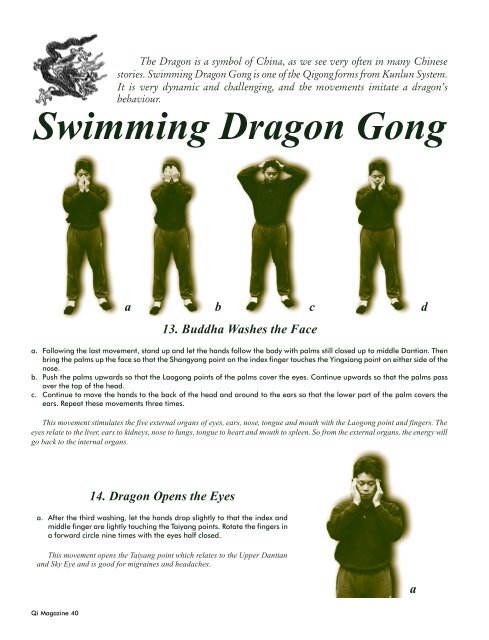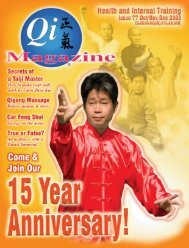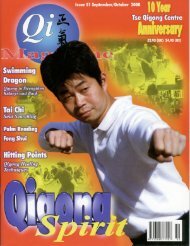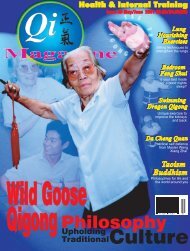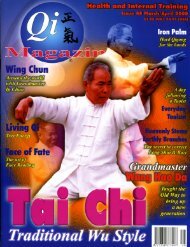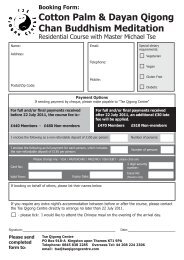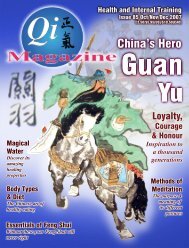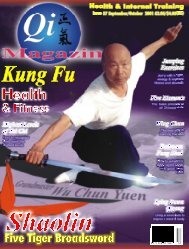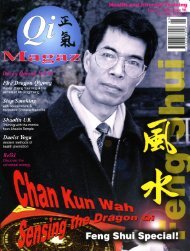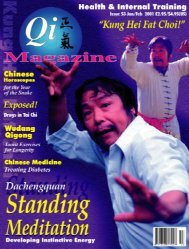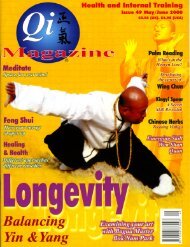Shanghai JournalThis marks the first part of an inside look at the life, people,teachers and skills in the City of Shanghai.In April 2000 my wife and I passed onour Internal Arts School to our seniorstudents and embarked on ourcontinuing journey of discovery. While itwas a melancholy decision to leave solarge a part of our lives behind, oursuccessful Association, our roles asteachers, and our many friends across thecountry, we knew that in order to growwe must continue on the path ofScholarship.So in August of last year we beganagain, this time as students, in the greatcity of Shanghai. We werefortunate to have the supportof our Sifu, Master Xu GuoMing formerly ofShanghai, andintroductions to manyof the city’s premiermartial artists. Sincethen we have studiedhard, travelling tomany of the city’sfamous parks, andwitnessing skillsundreamed of in ourformer homeland.In the ensuingissues of thismagazine wewill keep youinformed ofour observationsandof the manyMasters andparks in Shanghai where the ChineseMartial Arts are practised. We will featureindividuals through interview andpictorial accounts and provide you withdetailed information on the differentsystems practised in the many individualparks of the city. When special occasionsarise in Shanghai, such as city orcountrywide demonstrations, exhibitions,or competitions, we will endeavour toreport on the atmosphere and results. Wehope to be able to provide you with muchof the news happening in one of thepremier centres of ChineseMartial Arts today.Initially, howeverwe would like todisclose our firstimpressions andthe opinion wearrived at as to whynative Chinesepeople have aninside edge in thedevelopment ofskills we all workhard to develop.A c r o s sShanghai we havenoticed the remarkablelevel of Sung(physical relaxation)the peopledisplay. Eventhough Shanghai is a typical example ofa big city, the people remain Sung in theirbodies. For one they do not accumulatetension in their necks, shoulders, andtrapezius muscles, the way westernersdo. They remain straight and upright,without the poor posture that we oftensee in London, New York, or Los Angeles.Many of the city’s public toilets are squataffairs and the people here are able tosit easily down into their hips even intoold age without strain or discomfort.Moreover their joints, ligaments,tendons, even muscle to some degree,enjoy a remarkable openness andextension I have not witnessed in mostwesterners. In short their bodies naturallyconform to many of the prerequisites thatare called for in the classical literature.Another obvious advantage theydisplay, regardless of whether theypractice Gong fu or not, is their Peng Jing,or ward off power. On more than oneoccasion, when we first arrived, we wouldbe bounced out of our root while goingthrough a door, in the cue, or whileshopping, only to discover a little old lady,or young Miss barrelling through. I’m nottalking about some bruiser but even theones you may classify as frail or scrawny,have this remarkable ability. Children,teens, and the elderly all seem physicallywell rooted as a result of their correctstructure, physical relaxation, andopenness.As a final point we noticed thathere in Shanghai the people arephysically quite demonstrative,enjoying a slap on the back as a signof affection or pushing and shovingto maintain their space withoutmalice. They do not to seem to havethe same aversion to physical contact,even enjoying what we would termas hard slaps or punches as sign ofaffection. Some of the displays wehave seen, most westerners wouldperceive as either an attack orunqualified inappropriate behaviour.Join us next time for our reporton the happenings at Kang Jain & CaoYang Parksby J. Reynolds NelsonShanghai JournalQi Magazine 39
The Dragon is a symbol of China, as we see very often in many Chinesestories. Swimming Dragon Gong is one of the <strong>Qigong</strong> forms from Kunlun System.It is very dynamic and challenging, and the movements imitate a dragon’sbehaviour.Swimming Dragon Gongab c d13. Buddha Washes the Facea. Following the last movement, stand up and let the hands follow the body with palms still closed up to middle Dantian. Thenbring the palms up the face so that the Shangyang point on the index finger touches the Yingxiang point on either side of thenose.b. Push the palms upwards so that the Laogong points of the palms cover the eyes. Continue upwards so that the palms passover the top of the head.c. Continue to move the hands to the back of the head and around to the ears so that the lower part of the palm covers theears. Repeat these movements three times.This movement stimulates the five external organs of eyes, ears, nose, tongue and mouth with the Laogong point and fingers. Theeyes relate to the liver, ears to kidneys, nose to lungs, tongue to heart and mouth to spleen. So from the external organs, the energy willgo back to the internal organs.14. Dragon Opens the Eyesa. After the third washing, let the hands drop slightly to that the index andmiddle finger are lightly touching the Taiyang points. Rotate the fingers ina forward circle nine times with the eyes half closed.This movement opens the Taiyang point which relates to the Upper Dantianand Sky Eye and is good for migraines and headaches.aQi Magazine 40


